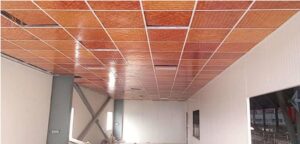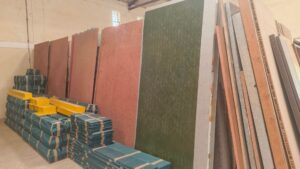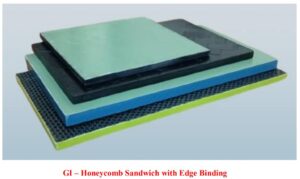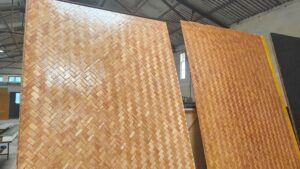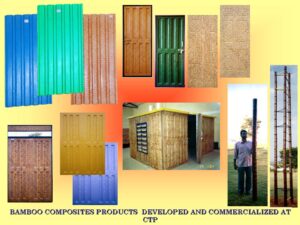In the evolving world of engineered panel systems, one of the standout solutions for high performance and structural reliability is the bamboo–honeycomb–bamboo sandwich panel built around a phenol-coated high-density craft-paper honeycomb core. With thicknesses ranging approximately from 12.5 mm to 50 mm, these panels combine lightweight construction with rigid performance, making them a compelling choice for premium interiors, modular units, marine/rail bulkheads and structural cladding. According to the specification sheet, the core is described as a high-density (about 100 kg/m³) craft paper honeycomb, phenol coated, bonded under high-heat pressure using aerospace-derived hot-press technology.
Below is a detailed breakdown of how the technology works, key properties, applications, advantages and limitations — all from a distributor, specifier or installer viewpoint.
What is Phenol-Coated Honeycomb Core Technology?
Honeycomb core technology refers to a cellular, lightweight internal structure (usually hexagonal cells) that is sandwiched between two thin but stiff face sheets (in this case bamboo composite laminates) to form a structural panel. The core’s role is to provide separation of the face sheets (which carry the in-plane tensile/compressive loads) and resist shear loading, thus allowing high bending stiffness with relatively low weight.
In this particular panel system:
The core material is a high-density craft paper honeycomb impregnated/coated with phenolic resin (phenol-coated) for improved moisture resistance, stability, termite/fungus resistance and fire retardancy.
The face sheets are bamboo composite laminates—woven bamboo mats impregnated with resin, hot-pressed for strength and durability.
The bonding of core to face sheets uses high-performance adhesives and hot-pressing (temperature + pressure) to produce a panel free of delamination, voids and with structural integrity.
This technology therefore allows the creation of panels with large thickness (10-50 mm) but low density (as low as ~171 kg/m³ in some thicknesses) and impressive weight-reduction compared to steel or other heavy structural panels. For example:
At 12.5 mm thickness: volume density ~371 kg/m³ and ~95% weight reduction compared to steel.
At 53.5 mm thickness: volume density ~171 kg/m³ and ~98% weight reduction vs steel.
Key Properties & Performance Benefits
Light weight yet high stiffness: Because the honeycomb core allows separation of the face sheets, bending stiffness is increased much more than increasing mass would. This gives improved structural behaviour for large panel spans, partitions, ceilings or cladding.
Dimensional stability & durability: The phenol coating and resin-impregnated skins combine to make panels that resist moisture, fungus, termite attack, corrosion (in humid environments) and maintain flatness and integrity over time. The specification lists “moisture resistant, non-corrosive, termite proof, thermal/electrical/acoustic insulation, impact resistant”.
Thickness flexibility: The technology allows panels of 12.5 mm up to 50 mm (and beyond) thickness, meaning they can be specified for light architectural facades, interior wall systems, furniture substrates, bunk beds, marine/rail bulkheads, etc.
Sustainability credentials: By using bamboo composite skins together with a craft-paper honeycomb core (phenol-coated), the panels present a lower embodied weight, reduced raw material consumption (versus solid wood or metal panels), and long service life — all beneficial in eco-conscious projects.
Thermal/acoustic insulation benefits: The panel structure (skin-core-skin) provides intrinsic insulation benefit because of the air-cell core and layered structure. The specification explicitly mentions acoustic insulation among properties.
Applications for this Technology
Interior partitions and wall/ceiling panels: Where large areas, high finish, and low load-on-structure are desirable — e.g., luxury hotels, corporate interiors, modular buildings.
Furniture and built-in joinery: Thick panel formats like 25–50 mm can be used for bunk beds, cabinetry, wardrobe systems especially in demanding environments (marine, rail, resort).
Marine, rail, defence bulkheads and hatch covers: The weight savings, durability and panel format make these panels suitable for transport interiors. The specification mentions bunk beds, hatch covers, bulkheads for boat/ship, railways.
Exterior cladding or modular panel building systems: Where light load on framing, quick installation and durability matter; the sandwich panel delivers structural depth without heavy weight.
Green building and modular construction: The lightweight high-performance format supports prefabrication, transportation savings, reduced structural support, and material efficiency.
Advantages & Limitations (Pros & Cons)
Pros
High strength-to-weight ratio: Enables large spans, thinner support framing, easier handling and installation.
Durability in adverse conditions: Moisture, termite, fungus resistance reduce lifecycle replacement cost.
Thickness versatility: Multiple panel thicknesses support varied use-cases from furniture to architectural wall panels.
Sustainable material story: Bamboo skins + craft-paper core reduce reliance on heavy resources and fit renewable material narratives.
Flat high-finish surfaces: Because skins are engineered composite, finish quality and appearance can be premium.
Cons / Considerations
Higher initial cost versus commodity panel materials: The composite manufacturing, honeycomb core and hot-press bonding add cost.
Design and installation demands: Sandwich panels require correct support framing, fixings, edge treatment, and attention to panel behaviour (cut-outs, fixings, bending) to avoid damage or delamination.
Fabrication/ detailing expertise: While manageable, projects using these panels benefit from specifying skilled installers accustomed to composite panels rather than standard wood panels.
End-of-life / recycling complicity: The composite nature (resin-impregnated skins + honeycomb core) may make separation and recycling more complex compared to plain wood panels.
Finish expectations: While skins are high-quality, the panel edge, cut-out and visible section detailing must maintain aesthetic integrity; raw core or exposed edges may not match high-end finish requirements.
Frequently Asked Questions (FAQs)
Q1: What thickness range is available for these bamboo-honeycomb sandwich panels?
A: Typical available thicknesses per specification are 12.5 mm, 18.5 mm, 25.5 mm, 40 mm and 53.5 mm. The density drops as thickness increases, illustrating the honeycomb effect.
Q2: How much weight reduction can these panels provide compared to steel or solid wood panels?
A: As per product data: at 12.5 mm thickness, ~95% weight reduction vs steel; at 53.5 mm, ~98% weight reduction. (volume density ~371 kg/m³ at 12.5 mm; ~171 kg/m³ at 53.5 mm)
Q3: Are these panels moisture and termite resistant?
A: Yes. The specification highlights moisture/boil‐water resistance, termite proofing and non-fungus behaviour as core performance traits of these panels.
Q4: Can these panels be cut, drilled or machined like regular wood panels?
A: Yes, but because they are sandwich composites, care is needed for cut-outs, fixing positions and edge finishing to ensure core integrity and avoid delamination. Specification references suggest that high-performance bonding and hot curing ensure structural integrity.
Q5: What kind of core is used and why is it phenol-coated craft paper?
A: The core is described as “phenol coated high density (≈100 kg/m³) craft paper honeycomb”. Phenol resin impregnation/coating provides improved moisture resistance, higher strength in wet conditions and better bonding with face skins. The craft paper honeycomb structure offers a good balance of stiffness, shear strength and lightweight behaviour.
Q6: In what kind of projects should these panels be specified?
A: Where high performance, lower weight, durability and premium finish matter. Examples: marine/rail interiors, modular buildings, resorts/cottages, furniture built-in joinery, feature walls/ceilings, transporting large panels with minimal structural support. The specification mentions bunk beds, hatch covers and built-in cabinetry applications.
Conclusion
Phenol-coated honeycomb core technology underpins a high-performance sandwich panel system when paired with bamboo composite skins. This combination delivers strength, stability, lightweight construction and sustainability. For architects, designers and specifiers seeking advanced panel solutions that push beyond conventional plywood or MDF, these panels offer compelling advantages in applications where weight, durability, finish and environmental credentials matter.
When specifying such panels, focus on selecting the right thickness, ensuring substrate/structural support is matched, detailing for edge, cut-outs and fixings is correct, and review finishing and installation workflows. With proper specification and installation, bamboo-honeycomb sandwich panels offer a forward-looking material solution for modern interiors, transport modules, modular structures and high-end building systems.


